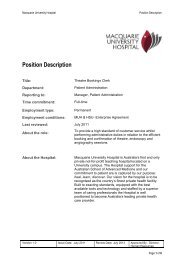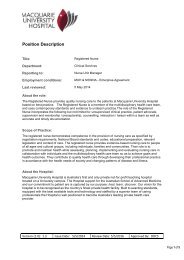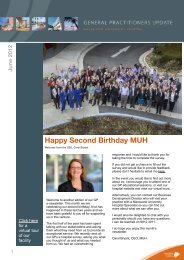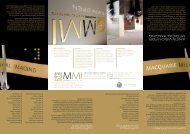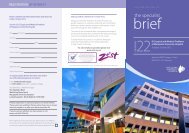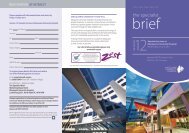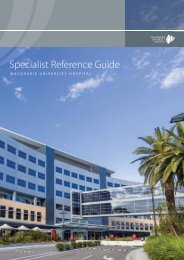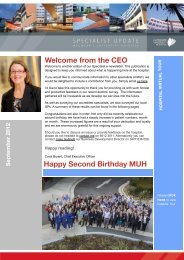Plenary Oral Presentations - Macquarie University Hospital
Plenary Oral Presentations - Macquarie University Hospital
Plenary Oral Presentations - Macquarie University Hospital
You also want an ePaper? Increase the reach of your titles
YUMPU automatically turns print PDFs into web optimized ePapers that Google loves.
16 th International Meeting of the Leksell Gamma Knife ® SocietyMarch 2012, Sydney, AustraliaFU-121Evaluation of Outcomes in Gamma Knife StereotacticRadiosurgery in Treatment of Trigeminal Neuralgia2Alyssa Zemanek, 1,3 Peter Shin, 1,2 Randy Sorum, 1,2 Michael McDonough, 1,2 Kenneth Bergman,1,2Dean Mastras, 1,2 Kevin Sanders, 1,2 Nathan Bittner, 1,2 Ann Pittier, 1,2 Herbert Wang1South Sound Gamma Knife, Tacoma, USA2Tacoma/Valley Radiation Oncology Centers, Tacoma, USA3South Sound Neurosurgery, Tacoma, USAObjective: It is well documented that stereotactic radiosurgical lesioning of the trigeminal nerve entryis an effective treatment of trigeminal neuralgia [TN], and an appealing alternative to invasive treatments.This study details the outcomes of 79 cases.Methods: This study consisted of a retrospective chart review of 79 cases in 73 patients treated withGamma Knife stereotactic radiosurgery (GKSRS) at our facility. A single 4 mm shot of 75-85 Gy forprimary treatment and 50-70 Gy for secondary treatment was delivered with the Leksell GammaKnife 4C to the trigeminal nerve 4 to 7 mm from its origin from the brainstem while limiting theradiation dose to the brainstem to the 20% isodose line. Of those 79 cases, seven were secondaryGKSRS treatments. Two patients had been lost to follow-up, leaving 71 patients available for analysis.Results: Median follow-up was 30 months. Mean dose administered for primary treatment was 79.4Gy (range, 75-85Gy); for secondary treatment it was 57.1 Gy (range, 50-70Gy). A total of 91.2% ofpatients undergoing their first GKSRS experienced pain relief following treatment at a median of 30days post -treatment. Of this population, 32.3% of patients experienced a recurrence of symptoms,at an average of 11 months after treatment. No significant differences were found between outcomesof subgroups including patients with multiple sclerosis, atypical TN, or those who had undergoneprevious surgical treatment for TN. There was no difference in outcome between the doses administered(75, 80, and 85Gy). For those patients receiving their second GKSRS for TN, there was an initialsuccess rate of 71.4% with 40% of that population eventually having recurring symptoms.Overall, 32.3% of patients developed some level of facial numbness. Of patients greater than 3 yearspost-treatment, (n=21), 52.4% experienced numbness, indicating a possible trend that this side effectmay increase over time.Conclusions: This study contributes to the growing body of research advocating that Gamma Knifestereotactic radiosurgery is an effective treatment of TN. Patient outcomes in terms of success of treatmentare comparable to other studies. No significant predictor of recurrence or failure was found.22



